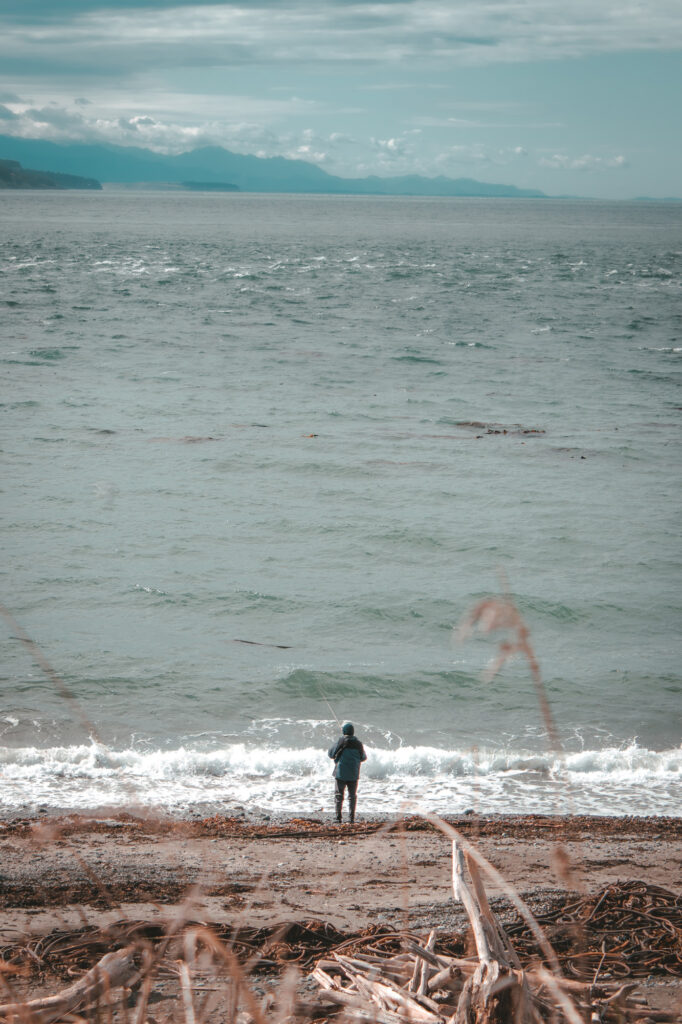
Just beneath the surface of a seemingly endless number of estuaries, bays, and inlets in Puget Sound and Hood Canal resides the sea-run cutthroat trout. The sea-run cutthroat trout are one of seven species of anadromous salmonids in the genus Oncorhynchus, and in late fall and winter these feisty fish provide decent catch-and-release fishing opportunities.
During the 1980s, the sea-run cutthroat population saw a dramatic decline, and by the 1990s, fishery managers decided to make this a catch-and-release only fishery in all local marine waterways. Since then, the sea-run cutthroat—which average between 10 to 20 inches in length—has seen a steady improvement in numbers, and the bonus is that anglers can pursue them 24/7 throughout Puget Sound with the southern reaches being one of the prime hotspots during certain times of the year.
A sea-run cutthroat, native only in North America from northern California to south-central Alaska, is an anadromous trout species that are born in rivers and streams, migrate out to saltwater locations and then return to spawn in rivers and streams. After spawning, adult cutthroat will move back out into the intertidal areas. Unlike other marine fish, you’ll often find sea-run cutthroat residing in areas with a varied bottom with rocks and gravel the size of a baseball. They also like to hide where trees overhang from the shoreline or within beds of eel grass. Another “go to” spot is around estuaries where freshwater from rivers or streams flush out into the saltwater.
The prime time to look for sea-runs is just before or right after flood tide change. Another tactic is to develop the ability to sight fish—you’ll often find them swimming an easy cast from the shoreline at depths of 10 to 20 feet but as shallow as 12 inches or less. Sea-runs can also be found where small baitfish and other prey congregate. Avoid pursuing them during an extreme outgoing tide as they prefer calmer water locations. If you plan to fish from the shoreline, stealth works to your advantage so don’t slosh about in the water and spook away the fish. There are times when you don’t need to put a foot in the water since these fish are often found within a short distance from the shoreline. Another factor to keep in mind is timing: when you find salmon fry there is the strong likelihood of a hungry sea-run cutthroat nearby.
Most who fish for sea-run cutthroat don’t disclose their favorite fishing locations but in general southern Puget Sound is best in the winter and spring and central and northern Puget Sound are better in the summer and fall. As far as public access areas go, you can look for fish along the shorelines around the Tacoma/Narrows Bridge, Redondo Beach, Lincoln Park to the Fauntleroy Ferry in West Seattle, Golden Gardens, Carkeek Park/Richmond Beach, Meadowdale Beach, and Picnic Point Park near Edmonds.
Those with a boat, kayak, raft, or small car-topper boat will be able to access areas more easily, especially those along shorelines that are inaccessible from land. Again, motor noise will spook the fish so it’s wise that your watercraft be equipped with oars or an electric trolling motor. Since this is a shallow water fishery, you’ll also need to keep an eye out for boulders hidden just under the water. A reliable pair of polarized sunglasses are high on the must-have list of fishing gear and they allow an angler to sight fish more easily and avoid those hidden dangers.
As for fishing gear, most anglers will cast flies or poppers, but lures also work, and it’s best to match it up to the feed such as euphausiids and amphipods (zooplanktons), herring, candlefish, salmon fry, crab, sculpin, sand shrimp, and worms. A small spoon like a ¼- to 1/8-ounce Dick Nite or Rooster Tail spinner in a size 2 or 3 are good for casting with a spinning rod and reel. Use dark color patterns during bright, sunny days or when water conditions are clear. Brighter colors get the job done when the water lacks clarity or around covered areas. Remember: barbless hooks are required when fishing in all Puget Sound marine areas. As for casting a fly, the popular choices are marabou clouser minnows, muddlers, or poppers. Pick an 8- to 9-foot, 5- or 6-weight fly rod with a fast action. A sealed drag reel is best for use in saltwater. Fishing line is also vital when it comes to fly fishing and many anglers will have back-up reels filled with sinking lines at various sink rates, and another set up with a floating line. Bait is an option, but should be avoided since this is a catch-and-release fishery and fish will likely inhale them much deeper, leading to an increased mortality rate. Fish on!


